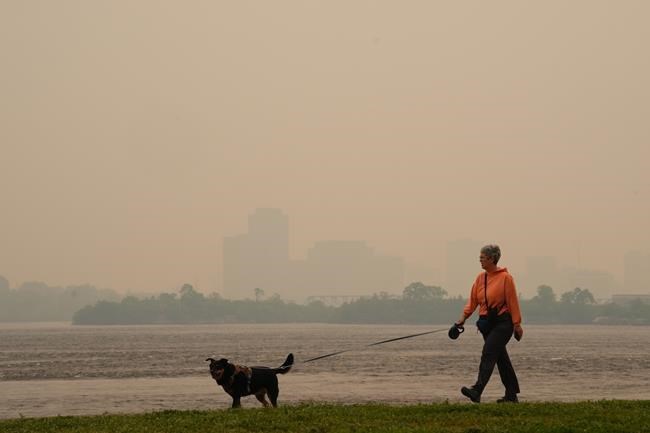OTTAWA — Hazy skies tinged with an eery yellow glow greeted millions of Canadians in Quebec and Ontario again Wednesday as the smoke from hundreds of wildfires continued to cause air quality warnings in Canada's most populated corridor.
In the morning, Environment Canada's air quality health index listed Ottawa and Gatineau, Que., as the worst in Canada, followed closely by the eastern Ontario cities of Kingston, Cornwall and Belleville.
Residents in those cities were encouraged to limit outdoor activities, and those most vulnerable to the smoke were told to avoid them altogether.
The smoke was so thick in downtown Ottawa that Gatineau's high-rise office towers were barely visible just a few hundred metres away across the Ottawa River.
In a bizarre twist of fate, on a day when air quality was among the worst the country has ever seen, it was national Clean Air Day in Canada.
"I want to recognize the air quality statements that have been issued by Environment Canada because of wildfire smoke," Prime Minister Justin Trudeau said on Parliament Hill.
"People across the country are being affected. We're seeing vulnerable people at risk, outdoor events cancelled, kids having to be kept inside at recess."
Emergency Preparedness Minister Bill Blair said more than 400 fires were burning across the country Wednesday, and more than half of them were still out of control.
The amount of land burned surpassed the 40,000 square kilometre mark, making 2023 Canada's fourth-worst fire season on record before the summer has even officially begun.
At the current pace of burning, the all-time record will be surpassed by next week.
"By all measures, this is perhaps the worst year we have experienced with wildfires," Blair said.
Although the majority of the fires are burning in northern and western Quebec, the smoke is affecting much of the Montreal-Windsor corridor, and is causing air quality warnings as far south as Washington, D.C.
In Ottawa and York Region north of Toronto, school boards cancelled outdoor recesses and sports leagues cancelled games and practices. The Toronto District School Board said all strenuous outdoor activities would be rescheduled or moved indoors when possible.
Individuals were also changing their plans to enjoy the great outdoors.
Yili Ma, 31, said a hiking group she belongs to has cancelled its plan to hike near the Toronto Zoo this week because of the air quality in Toronto.
"And also I'm not considering going to any patio. I put my mask away for over a year, and now I'm putting on my mask since yesterday."
Others are worrying about what this extreme fire season says about the future.
Oksana Perekhidouk said she initially thought it was fog marring the view from her 31st-floor apartment in Ottawa.
"It turns out it is smoke, and it's not good. So, I'm really worried, not even about the air condition, but about the forest," said Perkhidouk.
Brendan Lyver, 25, said it's frustrating that it is unhealthy to be outside.
"Forest fires, especially out east in Nova Scotia, that's not a common occurrence," he said. "So that's definitely something we need to address and look at what’s going on in the environment right now.”
The federal government is focused on battling the fires for now, but Trudeau acknowledged Wednesday his government is discussing the idea of creating some kind of national disaster response agency.
"We need to continue to make sure we are doing everything possible to keep Canadians safe when these extreme weather events happen, but also make sure we're doing everything we can to predict, protect, and act ahead of more of these events coming," he said.
"So we continue to discuss and look at new mechanisms and new ways of doing that."
A senior government source told The Canadian Press those discussions include analyzing models like the Federal Emergency Management Agency in the United States.
FEMA leads the U.S. government's programs to prepare for, prevent, respond and recover from natural disasters, terrorist attacks and other major incidents.
Initial disaster responses are currently the responsibility of municipal and provincial governments, which can ask for federal help when needed. Most often, that involves deploying the Canadian Armed Forces.
When the military responds in Canada, that work falls under Operation Lentus.
CAF documents show that the operation was triggered 21 times between 2018 and 2022, not including 118 requests for help from the military in 2020 to respond to COVID-19.
Chief of the Defence Staff Gen. Wayne Eyre has warned that the high demand on his troops for disaster assistance is straining the military's overall capacity.
More than 500 soldiers and military specialists are currently deployed in Alberta, Quebec and Nova Scotia in response to the fires, along with equipment including waterbombers and other aircraft.
This report by The Canadian Press was first published June 7, 2023.
— With files from Jordan Omstead and Kiernan Green in Toronto and Liam Fox in Ottawa.
Mia Rabson, The Canadian Press



